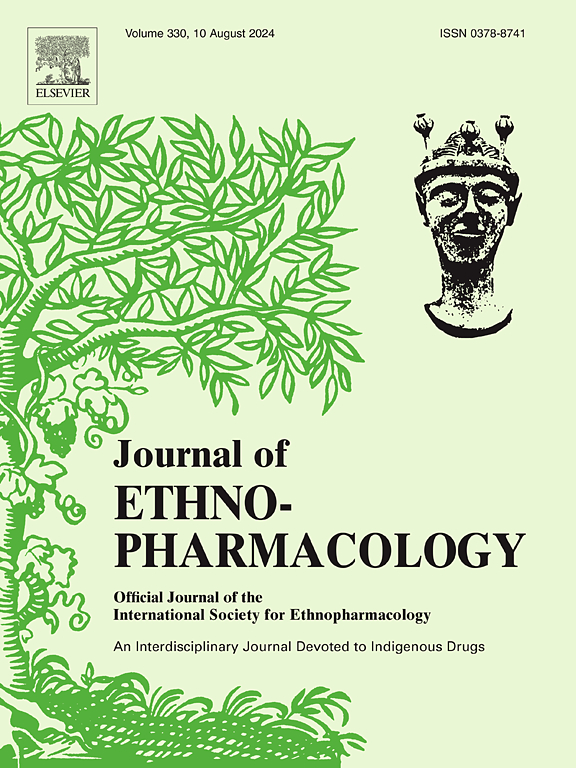菊花种子乙醇提取物的植物化学特性、抗氧化和抗炎特性:体外和体内研究
IF 4.8
2区 医学
Q1 CHEMISTRY, MEDICINAL
引用次数: 0
摘要
民族药理学相关性anethum graveolens L. (Apiaceae),在阿尔及利亚通常被称为“zareaat el besbas”,由于其治疗特性,传统上被用于阿尔及利亚的传统和现代医学中。目的分析石竹种子乙醇粗提物(CrdE)的化学成分,评价其抗氧化和抗炎活性。材料和方法对其总多酚和类黄酮含量进行分析。采用高效液相色谱-二极管阵列检测器(HPLC-DAD)对其主要生物活性成分进行鉴定。通过DPPH•、OH•、H2O2和NO•清除测定、脂质过氧化抑制、铁螯合和铁还原能力测定来评估其体外抗氧化活性。以5 g/kg剂量给药CrdE后评估急性毒性。采用二甲苯致水肿模型和角叉菜胶致水肿模型,分别以0.25、0.5和1 g/kg剂量检测小鼠体内抗炎活性。结果黄酮类化合物(3.02±0.03 μ QE/mg)和总多酚(26.33±0.87 μ QE/mg)含量显著。HPLC-DAD分析鉴定山奈酚(294.42 μg/g)、绿原酸(264.71 μg/g)和芦丁(144.68 μg/g)为主要活性成分。提取物在各种测试中显示出显著的抗氧化潜力,有效清除自由基,抑制脂质过氧化,并显示出金属螯合和铁还原能力。急性毒性研究显示在给药剂量下没有不良反应。在体内,CrdE可显著降低二甲苯诱导的(74%)和卡拉胶诱导的(83.55%)炎症模型的水肿。石榴籽含有丰富的生物活性化合物,具有显著的抗氧化和抗炎特性,支持其传统的药用价值。本文章由计算机程序翻译,如有差异,请以英文原文为准。

Phytochemical characterization, antioxidant and anti-inflammatory properties of Anethum graveolens L. seeds’ ethanolic extract: In vitro and In vivo studies
Ethnopharmacological relevance
Anethum graveolens L. (Apiaceae), commonly known as "zareaat el besbas" in Algeria, is traditionally utilized in both traditional and modern Algerian medicine for its therapeutic properties.
Aim of the study
To analyze the chemical composition of the ethanolic crude extract (CrdE) from A. graveolens seeds and evaluate its antioxidant and anti-inflammatory activities.
Materials and methods
The CrdE was analyzed for its total polyphenol and flavonoid contents. High-performance liquid chromatography-diode array detector (HPLC-DAD) was used to identify the predominant bioactive compounds. In vitro antioxidant activities were evaluated using DPPH•, OH•, H2O2, and NO• scavenging assays, lipid peroxidation inhibition, iron chelation, and ferric reducing power assays. Acute toxicity was assessed following the administration of CrdE at 5 g/kg. In vivo anti-inflammatory activity was tested using xylene-induced and carrageenan-induced edema models at a dose of 0.25, 0.5 and 1 g/kg.
Results
The CrdE contained significant levels of total polyphenols (26.33 ± 0.87 μg GAE/mg) and flavonoids (3.02 ± 0.03 μg QE/mg). HPLC-DAD analysis identified kaempferol (294.42 μg/g), chlorogenic acid (264.71 μg/g), and rutin (144.68 μg/g) as major bioactive compounds. The extract exhibited significant antioxidant potential across various assays, effectively scavenging free radicals, inhibiting lipid peroxidation, and demonstrating metal chelation and ferric reducing capabilities. The acute toxicity study revealed no adverse effects at the administered dose. In vivo, CrdE significantly reduced edema in xylene-induced (74 %) and carrageenan-induced (83.55 %) inflammation models.
Conclusions
A. graveolens seeds are a rich source of bioactive compounds with notable antioxidant and anti-inflammatory properties, supporting their traditional medicinal use.
求助全文
通过发布文献求助,成功后即可免费获取论文全文。
去求助
来源期刊

Journal of ethnopharmacology
医学-全科医学与补充医学
CiteScore
10.30
自引率
5.60%
发文量
967
审稿时长
77 days
期刊介绍:
The Journal of Ethnopharmacology is dedicated to the exchange of information and understandings about people''s use of plants, fungi, animals, microorganisms and minerals and their biological and pharmacological effects based on the principles established through international conventions. Early people confronted with illness and disease, discovered a wealth of useful therapeutic agents in the plant and animal kingdoms. The empirical knowledge of these medicinal substances and their toxic potential was passed on by oral tradition and sometimes recorded in herbals and other texts on materia medica. Many valuable drugs of today (e.g., atropine, ephedrine, tubocurarine, digoxin, reserpine) came into use through the study of indigenous remedies. Chemists continue to use plant-derived drugs (e.g., morphine, taxol, physostigmine, quinidine, emetine) as prototypes in their attempts to develop more effective and less toxic medicinals.
 求助内容:
求助内容: 应助结果提醒方式:
应助结果提醒方式:


